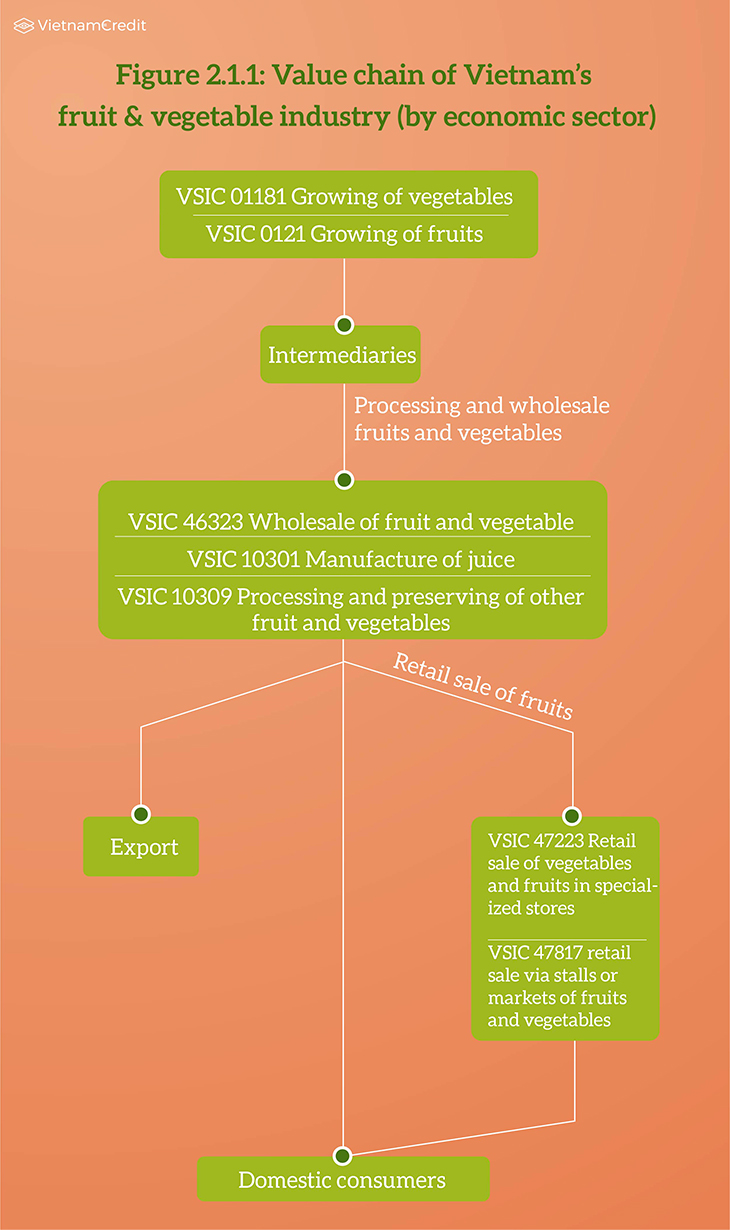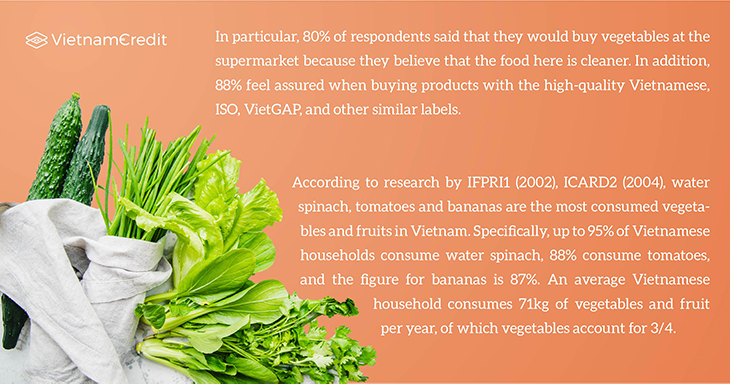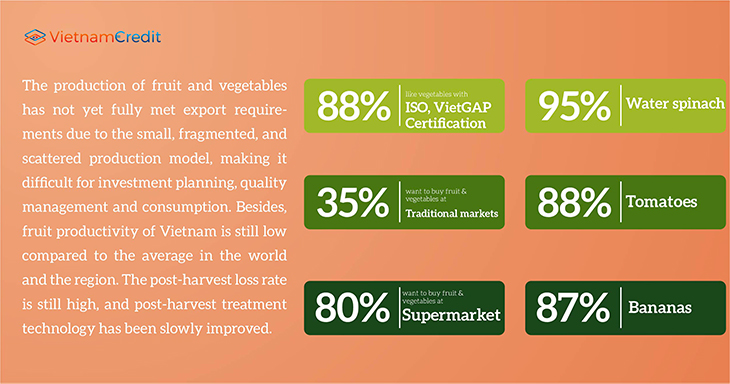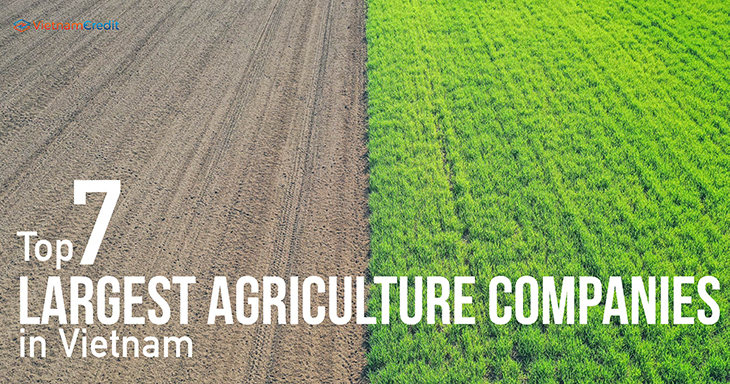In early October, VietnamCredit officially released Vietnam's Fruit and Vegetable Industry Report 2020, which gives general information about Vietnam's macroeconomic situation, and an insight into the fruit and vegetable industry, whilst highlighting various advantages and challenges that the industry is experiencing.
On top of that, the report also provides a list of the top 10 largest companies in the industry. These companies were selected by VietnamCredit based on their revenues, profits, credit ratings, and other non-financial factors.
Overview of Vietnam’s fruit & vegetable industry
The fruit and vegetable industry in Vietnam is made up of four main sub-sectors including manufacture of juice, processing and preserving of other fruit and vegetables, wholesale of fruits and vegetables, and retail sale of vegetables and fruits in specialized stores. Currently, there are 2,217 enterprises registered to operate in the fruit and vegetable industry in Vietnam.
Production of fruit and vegetables in Vietnam has increased steadily over the years, with a continually increasing land area for cultivation and production. Thanks to its effort in expanding the fruit and vegetable production capacity, Vietnam has become a country with a surplus of fruit and vegetables. Moreover, the import and export turnover of Vietnamese fresh produce has shown rapid growth. In 2019, the export turnover of this commodity was 2.1 times the import turnover.
With rising income, Vietnamese consumers are increasingly concerned with the quality of their food, and tend to use pesticide-free and organic vegetables. Fruits imported from the US, Australia, and New Zealand are very popular in Vietnam, although they are not cheap.

Value chain of Vietnam's fruit and vegetable industry by sub-sector
Production of fruit and vegetables in Vietnam is mainly conducted by farmers, which is disorganized. As a result, the production scale is small and scattered. Meanwhile, the domestic consumer markets are only major cities like Hanoi and Ho Chi Minh City. Therefore, farmers do not directly sell fruit and vegetables to consumers, but often sell to traders and wholesalers who have become a very important component in the value chain of the fruit and vegetable industry in Vietnam.
Vietnam’s fruit and vegetable consumption behavior
According to a study conducted by the Vietnam Academy of Agriculture in 2017, an average household living in big cities like Hanoi and Ho Chi Minh City spends about 8-9% of their monthly food expenditure on fruit and 12-13% on vegetables. More than 90% of the money spent on fruit and vegetables is in traditional markets, of which 47-52% is spent on fruit and about 58-67% for vegetables. The main reason consumers shop at traditional markets is because fruit and vegetables sold here are fresh.
However, Vietnam is a developing country and people's income is improving day by day, so consumption and demand for vegetables and fruit are also changing. When being asked about the most important factor influencing their decision to buy fruit and vegetables, consumers normally say that they prioritize "food safety" and the "freshness" of the product.
According to the survey of the Business Association of High-Quality Vietnamese Products (2019), consumers are increasingly concerned about quality, and tend to choose safe organic goods and products.
In particular, 80% of respondents said that they would buy vegetables at the supermarket because they believe that the food here is cleaner. In addition, 88% feel assured when buying products with the high-quality Vietnamese, ISO, VietGAP, and other similar labels.

According to research by IFPRI1 (2002), ICARD2 (2004), water spinach, tomatoes and bananas are the most consumed vegetables and fruits in Vietnam. Specifically, up to 95% of Vietnamese households consume water spinach, 88% consume tomatoes, and the figure for bananas is 87%. An average Vietnamese household consumes 71kg of vegetables and fruit per year, of which vegetables account for 3/4.
Fruit and vegetable consumption also varies by region. In the North, beans, kohlrabi and cabbage are widely consumed vegetables, while oranges, bananas, mangoes and other fruits are more consumed in the South. In particular, over 90% of rural households in the Northern mountainous regions and Red River Delta consume kohlrabi but only about 15% of households in the Southeast region and the Mekong River Delta consume this kind of vegetable.
According to a survey of Department of Crop Production - Ministry of Agriculture and Rural Development, imported fruit is preferred by Vietnamese consumers due to their better appearance and longer storage time.
Opportunities and challenges
Opportunities
Located in Southeast Asia, Vietnam has a tropical climate, so it has a diversity of fruits, especially those that have high export value. Moreover, Vietnamese people are more and more aware of health benefits from vegetables and fruits, so demand for imported fruits, and exotic, organic, and nutritious fruits is increasing.
In recent years, Vietnam has signed many multilateral and bilateral FTAs, which have helped Vietnam's fruits and vegetables become more popular throughout the world. In addition, to increase value added and market expansion, many companies have invested in new production and processing lines, and advanced and modern technologies.
Another factor that can be considered an opportunity for the Vietnamese fruit and vegetable industry is that this commodity currently holds a 59% market share of the global fresh food market, and have a growth rate of 2.88% in the period 2016-2021.
Challenges
Despite enjoying several advantages from global trade and consumers’ behaviors, the fruit and vegetable industry are facing a lot of obstacles.
First of all, impacts of climate change (drought, saline intrusion), harmful pests and diseases, and fertilizers have affected cultivation land, production, quality and food safety.
Secondly, the production of fruit and vegetables has not yet fully met export requirements due to the small, fragmented, and scattered production model, making it difficult for investment planning, quality management and consumption. Besides, fruit productivity of Vietnam is still low compared to the average in the world and the region. The post-harvest loss rate is still high, and post-harvest treatment technology has been slowly improved.

Thirdly, the area for planting fruit trees that applies safe production processes (GlobalGAP, VietGAP) remains low (10-15% of the total area), and intra-regional transportation system and specialized means of transportation have not been developed, and logistic costs and freight rates are high.
In addition, the distribution system is not professional, lacking linkages between businesses, farmers and consumers. There are too many intermediaries in the fruit value chain, causing high prices.
Most of Vietnam’s processed products are mainly for export, and many factories do not have stable raw material sources.
Last but not least, due to the fact that vegetables and fruits exported to the US and EU are strictly inspected, export of fruit and vegetable products of Vietnam are still facing many difficulties.
Vietnam Fruit and Vegetable Industry Report 2020
Source: Vietnam’s Fruit & Vegetable Industry Report 2020 - VietnamCredit

























































